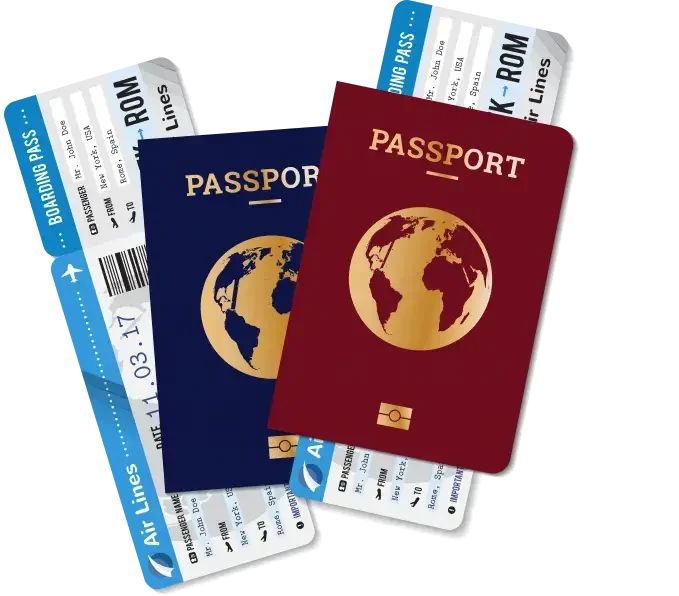Population
GDP (per capital)
Visa-Free Countries
GDP (purchasing power parity)
-
Understanding the USA EB-1 visa program (2025)
-
The EB-1 visa is a U.S. green card category for individuals with outstanding achievements in fields like science, arts, education, business, or athletics. It also covers top-tier professors, researchers, and multinational executives. A key benefit is that it often skips the labor certification process, making it one of the fastest routes to permanent residency.
-
As of 2025, the EB-1 remains current for most countries, though some applicants from high-demand regions may face delays. Recent USCIS updates now offer clearer criteria, especially for professionals in fast-growing sectors like artificial intelligence. For many high-achievers, the EB-1 offers a direct and efficient path to living and working in the United States.
- Main Industries
- Technology and Software Services
- Financial and Banking Services
- Healthcare and Pharmaceuticals
- Automotive and Aerospace Manufacturing
- Agriculture and Food Production
- Energy and Petroleum Industry

Washington D.C.
UTC−4 to −12, +10, +11
9,833,520 km2
USD
English

Who is it for?
The EB-1 visa is designed for individuals who have achieved exceptional success in their respective fields. This includes professionals with extraordinary abilities in areas such as science, arts, education, business, or athletics; distinguished professors and researchers with international recognition; and executives or managers who have held leadership roles in multinational companies. To qualify, applicants must provide substantial evidence of their accomplishments and demonstrate that their continued work will benefit the United States.
Key Advantages of the EB-1 Visa
- No labor certification (PERM): Skips the lengthy employer-sponsored verification process required in many other visa types.
- Faster green card processing: Typically has shorter wait times, making it one of the quickest ways to gain U.S. permanent residency.
- Option to self-petition (EB-1A): Applicants with extraordinary ability can apply without needing a job offer or employer sponsorship.
- Pathway for top global talent: Designed for individuals with significant accomplishments, offering a direct route to live and work in the U.S.

EB-1 Categories
EB-1 Categories
The EB-1 visa is split into three main subcategories, each aimed at different types of accomplished professionals. While they all offer a path to permanent residency, the eligibility criteria and requirements vary depending on the applicant’s background.
EB-1A: Individuals with Extraordinary Ability
This category is for people who have reached the top of their field in disciplines such as science, education, the arts, business, or athletics. What makes the EB-1A unique is that it does not require a job offer or employer sponsorship. Applicants can self-petition, meaning they initiate the process on their own behalf. To qualify, they must provide solid evidence of sustained national or international acclaim—this could include major awards, published work, press coverage, or original contributions of significant importance. The standard is high, but the flexibility of self-petitioning makes it especially attractive for independent professionals and freelancers.
EB-1B: Outstanding Professors and Researchers
This subcategory is intended for scholars who have earned recognition in academic or scientific communities. To be eligible, individuals must have a minimum of three years of experience in teaching or research at a high level and must have a permanent job offer from a U.S. university or qualified employer. Unlike EB-1A, this route requires sponsorship. Applicants must also show that they have made notable contributions to their field, often demonstrated through published articles, peer-reviewed work, memberships in prestigious associations, and professional references from respected experts.
EB-1C: Multinational Executives and Managers
The EB-1C is geared toward high-level executives and senior managers who have been employed by a multinational company outside the U.S. for at least one year within the three years before applying. The U.S. branch or affiliate of that company must sponsor the applicant, offering a role that mirrors the level of leadership they held abroad. This path is commonly used by international corporations to transfer top talent to their American offices. It’s also particularly beneficial for managers looking to relocate permanently without going through the lengthy labor certification process.
EB-1 Visa requirements overview (2025)
| category | Job Offer required? | Sponsorship Needed? | Main Eligibility Criteria |
|---|---|---|---|
| EB-1A | No | No | Demonstrate sustained national or international acclaim in fields like science, arts, education, business, or athletics; intend to continue work in the area of expertise; entry must substantially benefit the U.S. |
| EB-1B | No | Yes | At least three years of experience in teaching or research; international recognition; offer of a permanent research or teaching position from a U.S. employer |
| EB-1C | Yes | Yes | Employed outside the U.S. in a managerial or executive capacity for at least one year in the past three years; entering the U.S. to continue service with the same employer or affiliate |

2025 updates
The EB-1 visa landscape has seen several notable developments in 2025. From shifts in processing times to evolving application trends, understanding the latest changes can help applicants better prepare and improve their chances of success. Below is an overview of what’s new and what to expect this year.
Visa Availability and Priority Dates
As of April 2025, the EB-1 category remains current for most countries, meaning there are no major backlogs in visa availability. However, applicants from India may still face delays due to retrogression in their priority dates.
Processing Times
The average processing time for EB-1A petitions ranges from six to twelve months under standard review. Applicants who choose premium processing can expect a decision within 15 calendar days, offering a much faster timeline.
Application Trends
There has been a noticeable rise in self-petition filings, especially under the EB-1A category. At the same time, USCIS has increased scrutiny of applications, making the review process more selective. Approval rates have dropped—from 70.5% in fiscal year 2023 to 60.65% in 2024—highlighting the importance of submitting well-documented cases.
Growing Interest from AI Professionals
Applicants working in artificial intelligence and related sectors are increasingly pursuing EB-1 visas. While their profiles are encouraged, recent executive orders have introduced new evaluation guidelines that may impact how these cases are assessed.
Full EB-1 Application Process (2025)
- Prepare and Gather Evidence: Collect all necessary documentation to prove eligibility (awards, publications, job offer, employer letters, etc.).
- File Form I-140 (Immigrant Petition): This is the core petition showing you’re eligible for EB-1.
- EB-1A: You may self-petition.
- EB-1B & EB-1C: Requires employer sponsorship.
- Request Premium Processing(Optional): Pay an extra fee to receive a response on the I-140 within 15 calendar days.
- Wait for USCIS Decision on I-140: If approved, you can move forward. If denied, USCIS will explain the reasons and you may appeal or reapply.
- Priority Date Becomes Current: Check the Visa Bulletin. If your category is current, you can proceed. (As of April 2025, EB-1 is current for most countries.)
- File for Green Card (depends on location):
- Inside the U.S.: File Form I-485 (Adjustment of Status).
- Outside the U.S.: Begin Consular Processing via the National Visa Center (NVC).
- Attend Biometrics Appointment (if in the U.S.): USCIS will collect your fingerprints, photo, and signature.
- Interview (if required)
- Most I-485 applicants attend an in-person interview.
- Consular applicants will have their interview abroad.
- Receive Final Decision
- If approved: You’ll receive your green card in the mail (or visa stamp if abroad).
- If denied: You’ll be notified with reasons and next steps (appeal, refile, etc.).

EB-1 Visa Application Fees (2025)
| Form/ service | Fee (USD) | Notes |
|---|---|---|
| Form I-140(Immigrant Petition for Alien Worker) | $715 | Standard filing fee for all EB-1 subcategories. |
| Asylum Program Fee (Required with Form I-140) | $600 | Applies unless eligible for a reduced fee or exemption. |
| Form I-907(Premium Processing) | $2,805 | Optional service to expedite Form I-140 processing to 15 calendar days. |
| Form I-485(Application to Register Permanent Residence or Adjust Status) | $1,440 | Applicable if adjusting status within the U.S.; includes biometrics. |
| Consular Processing (DS-260 Application) | $325 | For applicants processing through a U.S. consulate abroad. |
| USCIS Immigrant Fee | $220 | Required after visa issuance for applicants outside the U.S.; covers the cost of producing and delivering the Green Card. |
Important Notes:
- The Asylum Program Fee is an additional charge introduced to support the asylum system; some applicants may qualify for a reduced fee or exemption based on specific criteria.
- Premium Processing is optional and expedites the Form I-140 decision to 15 calendar days.
- For the most accurate and personalized fee information, consider using the USCIS Fee Calculator.
Common Mistakes & Tips for a Strong EB-1 Petition
Common Mistakes & Tips for a Strong EB-1 Petition
Applying for an EB-1 visa can be a powerful path to permanent residency—but many applicants face delays or denials due to avoidable errors. Below are some of the most frequent issues, along with practical tips to help build a compelling and well-prepared case.
⚠️ Common Mistakes
- Insufficient Supporting Documents: Many applications are rejected simply because they lack strong evidence. USCIS looks for clear, detailed proof of your achievements—not just claims.
- Misunderstanding the Eligibility Criteria: Each EB-1 subcategory has specific requirements. Confusing the standards for EB-1A with those for EB-1B or EB-1C can lead to filing under the wrong category.
- Weak or Generic Recommendation Letters: Letters that sound vague, overly complimentary, or don’t explain your impact in the field often do more harm than good.
✅ Pro Tips for a Strong Application
- Focus on Quality Over Quantity: Submitting a smaller number of well-documented accomplishments is better than flooding your petition with less meaningful materials.
- Strengthen Your Public Profile: Consider publishing in recognized journals, speaking at major conferences, or getting featured in media that reaches a broad audience.
- Craft Clear, Specific Letters of Support: Choose recommenders who know your work firsthand and can speak credibly about your contributions and global impact.
- Stay Current on Policy Trends: USCIS scrutiny has increased in 2025, especially for self-petitioned EB-1A cases. Make sure your evidence meets the most current review standards.
Final word
The EB-1 visa continues to stand out as one of the most attractive immigration options for highly skilled individuals, thanks to its faster processing times, ability to bypass labor certification, and flexibility for top global talent. Whether you’re an acclaimed researcher, a rising entrepreneur, or a senior executive, this category offers a streamlined path to permanent residency.
That said, success with an EB-1 petition often depends on careful planning and solid documentation. Starting early gives you the time to gather strong evidence, build your professional profile, and avoid common mistakes. If you’re unsure about your eligibility or how to present your case effectively, seeking advice from a qualified immigration attorney can make a significant difference.
In a landscape where policies and standards continue to evolve, a well-prepared application can be your best advantage.
FAQ about USA EB-1 visa program
Who qualifies for an EB-1 visa?
Do I need a job offer for the EB-1 visa?
It depends on the category. EB-1A applicants do not need a job offer and can self-petition. EB-1B and EB-1C applicants must have a job offer and sponsorship from a U.S. employer.
How long does it take to process an EB-1 visa in 2025?
Standard processing for Form I-140 takes about 6 to 12 months. With premium processing, a decision is issued within 15 calendar days.
What makes a strong EB-1 petition?
A strong petition includes solid documentation like major awards, publications, media features, and specific letters of recommendation. Quality and credibility of evidence are more important than quantity.
What are the main advantages of the EB-1 visa?
Key benefits include no labor certification, faster green card processing, and self-petitioning for EB-1A. It’s one of the quickest routes to permanent residency for high-achievers.
Are there any 2025 updates I should be aware of?
Yes. EB-1 remains current for most countries, but scrutiny has increased—especially for self-petitioners. AI professionals are seeing more interest, but must now meet new evaluation guidelines.
Looking for expert visa support?
PROGRAM MATCH
Compare the different programs in a nutshell and discover their features
PROGRAM COST
Check the cost estimates for each offered program
PROGRAM MAP
Explore the power of global mobility for every passport in the world
